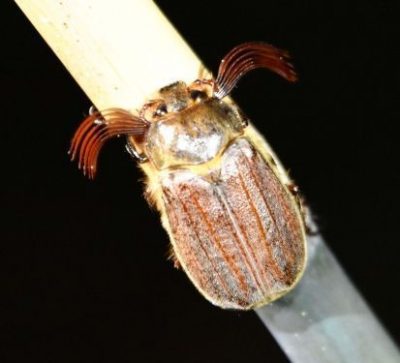Admirable love among indigenous beetles in the Takae Forest

Participants gently placing the Tricholontha papagena on their palms and touching its soft fur on its chest.
December 30, 2016 Chie Tome of Ryukyu Shimpo
There is an insect that spends two years underground as larva and then comes out of the ground during an evening around Christmas in search of its soulmate. This romantic insect, the Tricholontha papagena, is a beetle endemic to the Amami and Okinawa Islands. In particular, most inhabit areas around Takae district of Higashi Village. These beetles emerge as adults once every two years. This year happened to be that year. As a result, on the evening of December 23, an excursion to observe these beetles in Takae was held under the supervision of Akino Miyagi, who researches butterflies. A total of 12 people from inside and outside of Okinawa participated.
While these beetles can be found all over the Okinawa Island, Takae and Aha of Kunigami Village by far has the largest population. Just recently on December 16, a male was found near Zone H of the Northern Training Area.

A male Tricholontha papagena clinging to a Ryukyu bamboo branch and spreading its big antennas wide to detect a female’s pheromones on the evening of December 23 at Takae of Higashi Village.
The weather was clear on December 23. Under a sky full of stars, participants carried flashlights in one hand as they walked deeper into the forest. A total of 12 male beetles, spreading their antennas wide, frantically trying to detect a female’s pheromones, were found in the light trap that was set up beforehand. Taking a closer look, the magnificent chest fur, which gives it its Japanese name, comes into view. The participants gently placed the beetle in their palms and observed the beetle. They broke into smiles as they realized that the beetles become cuter the longer they look at them.
Meanwhile, Miyagi who has continuously watched over Takae and its nature, let the following slip: “With the helipad construction going on, (the beetles) won’t be able to surface if the ground is covered with gravel and/or concrete. But if they don’t go underground, they will be eaten by predators, like birds.”
Yuko Numata, a 53-year-old from Saitama Prefecture, agrees with Miyagi. She said, “(These beetles) patiently wait two years underground for this moment. I was touched to hear about their admirable way of life in which they perish once they mate. I really wish man-made disasters, like the helipad construction, would not harm the wildlife.”
(English translation by T&CT and Chelsea Ashimine)
Previous Article:Nine Okinawan higher education institution presidents request Osprey flight suspension
Next Article:New Year’s banquet at Shuri Castle: Ryukyu Kingdom era ritual performed as prayer for peace
[Similar Articles]
- People enjoy seeing and collecting insects in Takae
- Protect the Yambaru Long-Armed Scarab Beetle: In three northern Okinawa villages, 30 people participate in patrol to prevent poaching
- Drive-thru giveaway: come get a free tadpole or beetle from this local breeder
- 71 unused U.S. blank cartridges found on returned NTA land, reminders of military presence
- Three rare butterfly species photographed in Takae on same day
 Webcam(Kokusai Street)
Webcam(Kokusai Street)


